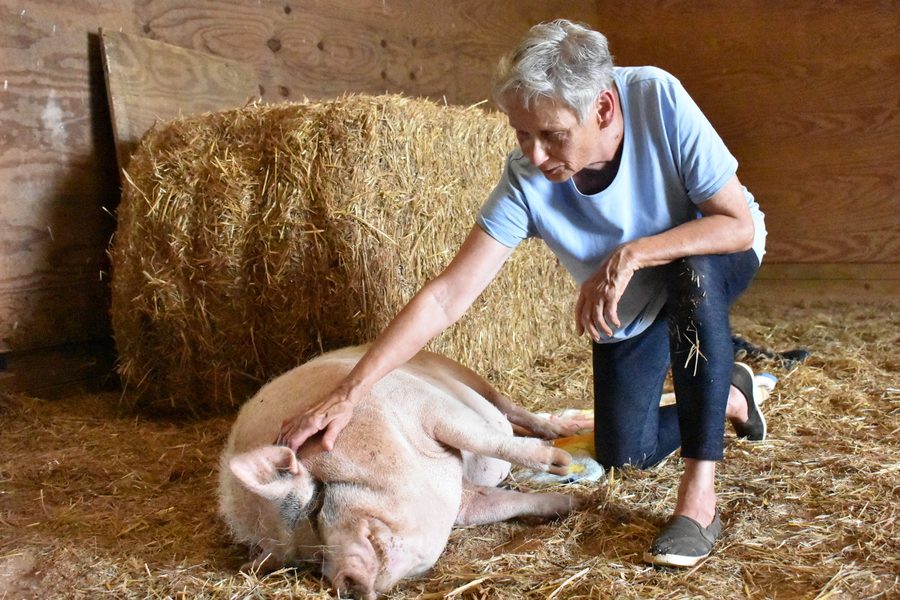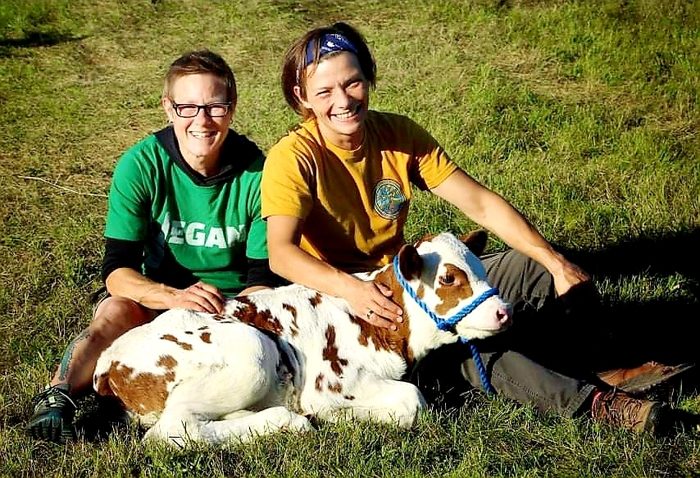For These Wisconsin Farms, Eating Animals is Off The Table
Inside the uneasy rural alliances between a growing movement of animal sanctuaries and their neighbors.
Marina Bolotnikova

Off the Table Farm Sanctuary, located in the middle of America’s Dairyland, is surrounded by farms, and to the uninitiated, it appears like one. Rather, it’s a refuge for animals who have been saved from becoming food. When I meet its founders, Sarah and Kate Meyer, it’s one of the first cool days of the season, giving their property in Westfield, Wis., a crisp air. Eloise, a one-year-old special-needs cow, locks eyes with me as she loafs on her patch of pasture. Sarah points toward the sanctuary’s 39 acres of rolling hills, most of which are still empty, explaining that they eventually hope to populate it with rescued animals. “It’s not often you’ll find a married lesbian couple that has a farm sanctuary that are vegan in Marquette County,” she says. But it’s “a need, a calling.”
Founded in September 2020 after making their first rescue, Off the Table is home to five cows, three pigs and two goats. It’s one of at least 10 farm animal sanctuaries in Wisconsin, a growing community of organizations that promote veganism and provide shelter for former farm animals. Though animal sanctuaries and neighboring farmers often share similar goals, such as resisting the increasing industrialization of Wisconsin agriculture — arguing that factory farming fuels the climate crisis, pollutes communities air and water, and creates dangerous conditions for its workforce — relationships with rural communities are frequently strained. For many sanctuaries, their primary mission is to end animal agriculture entirely, along with the commodification of animals.
Animal rights activists say sanctuaries play a key role in the movement nationwide. In Wisconsin, farm sanctuaries seek to create a point of connection between urban and rural, contra veganism’s reputation as a lifestyle for out-of-touch urbanites. They’re largely run on volunteer labor, most of which comes from urban areas. Tiny Hooves, a large sanctuary in Union Grove (which was founded in 2015 and is now home to 184 animals), gets 40 volunteers per week mostly from Chicago and Milwaukee, says founder Beca Thompson.
During the pandemic, the grassroots animal activism group Milwaukee Animal Save has increasingly focused on providing volunteer help to sanctuaries, says organizer Nisha Kumar, who is also a regular volunteer at Tiny Hooves. For Kumar, helping sanctuaries with daily chores, like cleaning up after animals or cutting up food isn’t always exciting work, but it’s essential. Too often in the animal rights community, Kumar says, activists organize street protests without a clear goal. “Nine times out of 10, it’s pointless,” she says. “Cool, we disrupted McDonald’s for a day. Did we convince anybody to go vegan or to not eat there? No.”
Running a sanctuary also means being in frequent contact with area farmers, both to negotiate animal rescues and because their neighbors are predominantly farmers. These relationships can be tense, say Thompson and Meyer, but they’ve also helped create a measure of understanding and coexistence, if not agreement. “We’re surrounded completely by dairy, beef, and one large pig farmer,” Thompson says. “In the beginning, it was rough. It was really hard to handle the comments and the sarcasm and the anger.”
But “they realize that we’re fighting one of the same fights that they are, which is stopping big animal ag,” she says.
Animal sanctuaries and neighboring farms often share financial relationships as well. The Meyers rent a portion of their land to a neighboring dairy farmer, who uses it to grow feed crops for his cows. It was an arrangement he’d had with the previous owners of the land, and when the Meyers moved in, they felt very conflicted about working with him, but they didn’t want to be “judgey vegans.” “He knows we don’t like what he does, but we have a friendship,” Sarah Meyer says.
Animals find their way to farm sanctuaries in many ways. Sometimes they escape slaughter: Pigs and piglets, called “jumpers” within the sanctuary community, are known to sometimes jump from transport trucks on the highway. More often, a farmer or farm worker feels a surge of compassion for an animal who is too sick or disabled for production. That’s how the Meyers found Eloise. Born with curved legs, her mobility issues made her worthless to the Wisconsin dairy farm she was born to. But “the farmer’s wife fell in love with her,” Kate says. So they contacted Off the Table.
Eloise was lucky. When farm animals have health problems, “if it’s not something that’s easily fixed, they’re often just slaughtered,” says Lowell Wickman, a former Wisconsin dairy veterinarian who left the industry in 2008.

Because this is Wisconsin, farm sanctuaries also have a particular interest in shedding light on the dairy industry and its concomitant products, like veal. Thompson became vegan 15 years ago after watching a video about veal production. “I was like done, done, done,” she remembers. “And then I did the whole 30 days of withdrawal from cheese like everybody in Wisconsin does.” Two years ago, her sanctuary took in Hank, a former veal calf. “He was born on [a] dairy farm and then he was immediately taken from his mom. He was tied to a wall in the barn for the first six weeks of his life,” she says. “By the time he got here, at six weeks old, he was super broken. Just no spirit left in him. I think he just thought he was born to die.”
Quincy Markowitz, co-founder of Farm Bird Sanctuary in Edgerton, has for years been rescuing chickens from Pioneer Days, in the small village of Ridgeland, Wis. This yearly February festival hosts a central event called “the chicken toss,” during which hundreds of chickens are thrown from a rooftop into a crowd of people to catch and take home. “We’ve seen birds suffocated on site, stuffed into plastic bags,” says Markowitz. “I have pictures from one year of a group of people that caught a chicken and then made her drink beer.” Last year, Markowitz sued Ridgeland over the event, arguing that it violates state animal cruelty law.
“The Dunn County Sheriff’s Office has investigated these allegations for years and has not found anything that is in violation of the Wisconsin animal cruelty laws,” says Dunn County Sheriff Kevin Bygd.
Kumar and Milwaukee Animal Save organized an action at 2020’s Pioneer Days, drawing 60 activists from Wisconsin and other states. Groups of activists were assigned to protest, convince participants in the chicken toss to give the chickens away, and tend to the animals’ injuries. Many of the event-goers were angry about the activists’ presence, Kumar says, but they managed to rehome 24 chickens, and fundraised about $5,000 for their veterinary care.
Though Farm Bird Sanctuary’s lawsuit was ultimately unsuccessful, Markowitz felt it was important to draw attention to Pioneer Days because Ridgeland is “about as American, as rural, white community as it comes,” they say. Cruelty toward farm animals as a kind of entertainment, such as pig wrestling, happens at county fairs all over the country, whereas animal protection laws often disproportionately criminalize immigrants and communities of color. Racially inflected practices like cockfighting and dog fighting are widely criminalized in the United States, while routine, structural animal cruelty like what happens in animal agriculture is just business as usual, writes legal scholar Justin Marceau in his book Beyond Cages. Even investigations into animal abuse at factory farms have resulted in the arrests of immigrant workers and little else.
The mainstream animal movement has been complicit in advancing what Marceau calls “carceral animal law,” which creates severe penalties for marginalized people but has done little to actually improve animals’ standing in society. Because of this, Markowitz stresses the importance of anti-carceral strategies for challenging violence against animals. Even when they rescue birds from cockfighting, they say, “I refuse to give any information to the police…I’m not going to send people to prison that realistically are not doing anything that is that much worse than what’s legal.”
Back at Off the Table sanctuary, Ginger and Gem, a mother-and-daughter pair of Nigerian dwarf goats, sprint toward me like a pair of tussling cats. “It’s very rare to have a mom with her baby in sanctuary,” Sarah Meyer explains. “With goats, with cows, their babies are taken from them.” Though sanctuaries can be healing to people in the animal movement, they can also be bittersweet. For the Meyers, every animal enjoying relative freedom here is a reminder of the billions of others living lives of confinement. They love their animals immensely, which they say makes the massive amount of work, both physical and emotional, involved in running a sanctuary worth it. “They’re so full of life,” Sarah says. “They all have extreme personalities.”

